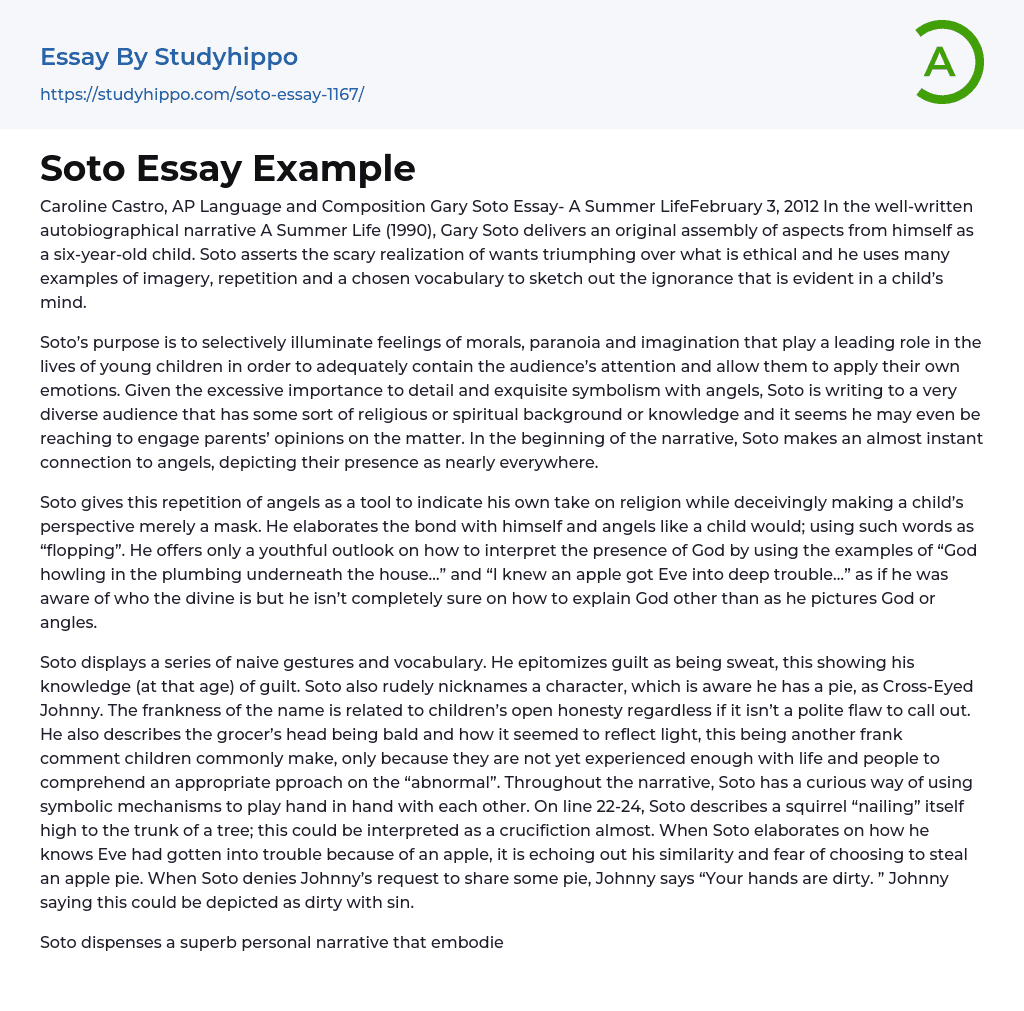Caroline Castro, AP Language and Composition Gary Soto Essay- A Summer Life February 3, 2012 In his autobiographical narrative A Summer Life (1990), Gary Soto effectively portrays the experiences and emotions of his six-year-old self. Soto explores the unsettling realization of desires overpowering moral values, employing various literary techniques such as imagery, repetition, and carefully chosen vocabulary to vividly depict the innocence found within a child's mind.
Soto aims to highlight the significance of morals, paranoia, and imagination in the lives of young children in order to capture the audience's attention and encourage them to connect with their own emotions. By emphasizing intricate details and symbolism surrounding angels, Soto appeals to a diverse audience with religious or spiritual backgrounds, possibly including parents. From the start of the story, Soto immediately introduces angels and depicts the
...ir pervasive presence.
Soto employs the repetition of angels to express his unique interpretation of religion, which cleverly camouflages a child's perspective. He describes his connection with angels in a manner reminiscent of a child, using terms like "flopping." He presents a youthful perspective on comprehending God's existence through instances such as "God howling in the plumbing underneath the house..." and "I knew an apple got Eve into deep trouble..." It is evident that he recognizes the divine but struggles to articulate God except as he imagines Him or angels.
Soto exhibits childlike gestures and language, showcasing his understanding of guilt as sweat. He also gives a disrespectful nickname to a character, referring to him as Cross-Eyed Johnny. The bluntness of the name reflects children's honesty, even when it may not be considered polite. Soto also describes the grocer's bald head, which seemed t
shine, a comment that again exemplifies children's straightforwardness in observing things they perceive as abnormal. Throughout the narrative, Soto uses symbolic elements that intertwine with each other. For instance, he mentions a squirrel "nailing" itself to a tree, which can be interpreted as a form of crucifixion. This parallels his knowledge of Eve's trouble with an apple, symbolizing his own fear and decision to steal an apple pie. When Soto refuses Johnny's request to share some pie, Johnny remarks that Soto's hands are dirty, implying that they are tainted with sin.
Soto tells a powerful personal story that captures the essence of a guilty child, despite their childish nature. He offers compelling examples of child-like behavior and language, intertwining them with his own remorseful memories of being a child who, like any other child, has committed sins and feared punishment. Specifically, he dreaded a religious or orthodox consequence for stealing a pie. Furthermore, he concludes his narrative with a profound realization, akin to a child accomplishing a new task, that while his sin would not be forgotten, it would indeed be forgiven.
- Child essays
- Childcare essays
- Child labor essays
- Doll essays
- Age Of Enlightenment essays
- Ethos essays
- Time essays
- Acceptance essays
- Meaning Of Life essays
- Reality essays
- Natural Law essays
- Political Philosophy essays
- Utilitarianism essays
- Existence essays
- Free Will essays
- Good And Evil essays
- Confucianism essays
- Relativism essays
- Conscience essays
- Environmentalism essays
- Empiricism essays
- Epistemology essays
- Ethics essays
- Existentialism essays
- Human Nature essays
- Individualism essays
- Metaphysics essays
- Philosophy Of Life essays
- Transcendentalism essays
- Truth essays
- Destiny essays
- Determinism essays
- Fate essays
- Functionalism essays
- Philosophers essays
- Pragmatism essays
- Future essays
- Child Observation essays
- Critical Reflection essays
- Teaching Philosophy essays
- Personal Philosophy essays
- Action Speak Louder Than Words essays
- Can Money Buy Happiness essays
- Values of Life essays
- Ethical dilemma essays
- Normative Ethics essays
- Virtue Ethics essays
- Belief essays
- Deontology essays
- Moral essays




